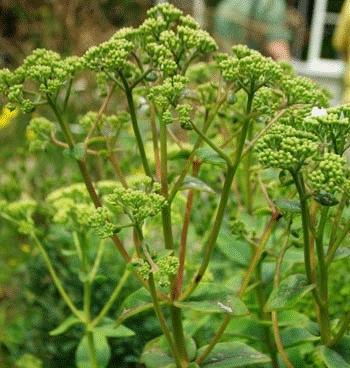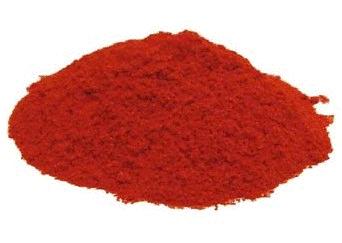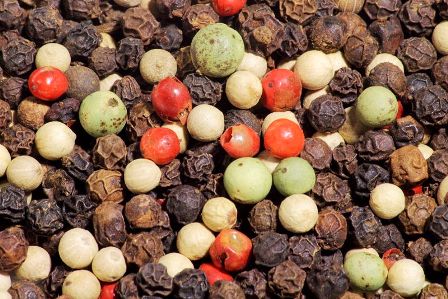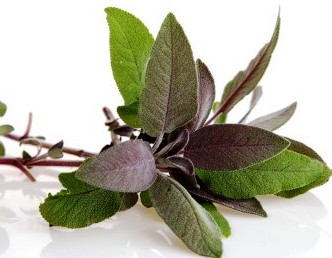Herbs and Spices
Fresh herbs and spices provide so much of the unique and special flavor we add to our cooking. This guide illustrates the many common herbs and spices that are referenced throughout the recipes at Family Recipe Central.
We like to recommend you use fresh herbs whenever possible. Fresh herbs have a naturally stronger and more aromatic taste than their dried counterparts. You can use herbs alone or in many different combinations to greatly enhance the natural flavoring of food.
| Anise |
ALLSPICE These reddish-brown berries are dried and ground or packaged as whole berries. Allspice has a sweet fragrance. The flavor is a combination of cinnamon, nutmeg and clove. Allspice can be used to season meat dishes, but is more commonly found in spiced cakes and cookies as well as fruit pie fillings. |
| Anise |
ANISE Fresh anise has a mild, licorice like flavor. It goes weill with gree salads, cucumber dishes, and in light soups and stews. |
| Basil |
BASIL This intensely aromatic herb, also known as the "royal herb", originated in Asia and is widely cultivated throughout the world today. Basil is particularly complimentary in tomato-based sauces and dishes, and is also the principle ingredient of pesto, and italian green sauce. |
| Bay Leaf |
BAY LEAF Dried and fresh bay leaves provide an excellent flavoring for sish stews, roast meats, marinades, and vegetable soups. |
| Borage |
BORAGE Borage is a mild herb that goes well with cucumbers and pickles. It is often used for seasoning salad dressings. |
| Caraway Seed |
CARAWAY SEED Whole or ground caraway seed is used to season stews, soups, rye bread, cheese, marinades, and certain vegetable dishes. |
| Cardamon |
CARDAMON Cardamon is used in much the same way as cinnamon and cloves for seasoning baked desserts and meat dishes. It is also delicious in marinades and barbecue sauces. |
 |
CAYENNE PEPPER Cayenne pepper is made from the ground pods of a special variety of hot red pepper. The chile pepper is named for the city of Cayenne in French Guiana. Also known as the Guinea pepper or the Bird pepper. The pepper pods are dried and ground to produce the fiery spice, which should be only used in very small amounts. |
| Celery Seed |
CELERY SEED Celery may be used in many different food dishes. It is available as a whole seed, ground seeds, and as a salt (salt flavored ground celery seed). Provides and excellent flavoring for stocks, stews, salads, dressings, seafood and vegetables. |
| Chives |
CHIVES The chive has a fresh and delicate oniony flavor, and isfound in a wide variety of dishes, including stews, mixed salads, herbed butters, tomato sauces, and soups. Chives mix well with all sorts of herbs and make an attractive garnish when freshly copped. |
| Cinnamon |
CINNAMON The small cinnamon tree is a bay leaf plant. Cinnamon is the dried inner bark of the tree. Ceylon cinnamon is mildly spicy and has a light color. Cassia is slightly bitter and darker. Cinnamon is sold in sticks or ground into a powder. It is used for desserts, added to drinks or coffee, and in small quantities, as a seasoning for meat and seafood. |
| Cloves |
CLOVES The clove is the dried bud of the tropical evergreen clove tree. Ground or whole, the clove is a strong-flavored, sweetly aromatic spice used for seasoning meat and vegetables. Because of the concentrated flavor of this spice, whole cloves are usually removed from a dish before serving. |
| Coriander |
CORIANDER Coriander seeds are used whole or ground. This spice is an excellent seasoning for stews and vegetables such as cabbage. |
| Cumin |
CUMIN Cumin is a classic flavoring used in cheese and unleavened bread. Also common in Middle-Eastern and Indian dishes. Whole or ground, cumin seeds are also frequently used in marinades and in chili and tomato sauces. |
| Curry |
CURRY Curry consists of 15 (or more) different spices, usually a mixture of chili, cloves, coriander, cumin, ginger, mustard, pimiento and other seasonings. curry is used in preparing meat, fish, poultry and vegetables. Very popular in Indian and Thai cooking. |
| Dill |
DILL Sweet smelling dill is ideal in preparing salads, light sauces, fish, and crabs. The feathery leaves are chopped into fragments, or the entire stalk may be used whole as a garnish. |
| Fennel Seed |
FENNEL Fennel is available as seeds or ground to a powder, and has a slight licorice flavor. Used principally to flavor certain types of holiday cookies and pastries, it also makes an interesting seasoning for fish, vegetables, salads and sweet dishes. |
| Ginger |
GINGER The ginger plant forms tuberous roots that may be used fresh, preserved in a syrup, dried or powdered. This slightly hot spice is suitable for seasoning poultry, lamb and other meat, as well as gingerbread spiced cookies and cakes. Ginger is a common seasining in Thai cooking. |
| Juniper Berries |
JUNIPER BERRIES Dried juniper berries are suitable for seasoning sauces and stocks, meat or fish dishes, and cabbage. Juniper berries are also used for flavoring gin. |
| Lemon Balm |
LEMON BALM Lemon balm is actually a variety of mint. The leaves have a spicy lemon flavor, and are used to season salads, poultry and veal, as well as light sauces and soups. Lemon balm may be used to garnish many sweet dishes. |
| Lovage |
LOVAGE Lovage is an excellent herb for flavoring stews, sauces for meat, and for cooking peas and beans. This herb was popular with cooks in ancient Rome. |
| Mace |
MACE The outer coat of the nutmeg is called mace. Available dried and ground, this pleasingly aromatic spice is excellent as a pie seasoning. It may be used wherever nutmeg is found as an ingredient. |
| Marjoram |
MARJORAM Marjoram originated in the Mediterranean countries. Only the leaves, which have a strong flavor, are used as a seasoning. Marjoram is recommended for hearty stews, ham dishes, soups, and stuffed poultry. |
| Mustard Seed |
MUSTARD SEED Whole mustard seed is used in preparing marinades, fish stews, and pickles. Ground mustard seed produces mustard powder, used as the main component fo all types of mustard. |
| Nutmeg |
NUTMEG Nutmeg is the fruit of the evergreen nutmeg tree that grows in tropical regions. This spice is used to season many vegetables, white sauce, and certain cookies and pastries. |
 |
ORPINE Native to Eastern Europe, the somewhat astringent and aromatic leaves of the orpine plant are sometimes used to flavor fresh salads and soups. |
 |
PAPRIKA Spicy paprika is primarily grown in Hungary, Bulgaria, Greece and Spain. The pepper pods are dried and ground in different varieties to produce sweet or hot paprika. This spice makes an excellent seasoning for many types of savory dishes. |
| Parsley |
PARSLEY Parsley is one of the most common and widely available fresh herbs. Common, or curly-leafed parsley has a milder flavor than the broad, smooth-leafed Italian parsley. Parsley leaves are often used as a garnish, but to achieve the full flavoring, use the whole stem and stalk along with the leaves to prepare stocks and soups. |
 |
PEPPER Pepper is primarily cultivated in India, Indonesia, and Brazil. This basic and key seasoning comes from the peppercorn which is the small round fruit of the flowering vine pepper plant. As peppercorns ripen, they shift from green through red and black, all the way to a yellow white. The different color peppercorns are available whole and ground. White pepper is the hottest and black pepper tends to have the spiciest flavor. |
| Rosemary |
ROSEMARY Rosemary has a piquant, spicy, slightly bitter flavor. It is typically used to season roasted or grilled meat and fish. Rosemary is perfectly suited as a flavoring for lamb, chicken, zucchini and tomatoes. |
| Saffron |
SAFFRON Saffron is taken from the yellow flower of the crocus sativa plant, a species of the crocus plant family. Safron is difficult to harvest which makes it an expensive spice ingredient. A mild spice widely used in Mediterranean cuisine, saffron also turns any food it seasons a bright yellow color. |
 |
SAGE Sage has a hearty strong flavor and should be used in moderation. It is frequently used to season fish, liver, lamb and pork, and also as a secondary seasoning for tomato sauces. |
| Savory |
SAVORY Savory grows abundantly in the countries around the Mediterranean Sea. Both the leaves and the stalk of the savory plant are used for flavoring. Savory is suitable in preparing all sorts of beans, stews, and lamb dishes as well as sauces. |
| Sesame Seed |
SESAME SEED This plant which produces pods with little, oval seeds, grows in the tropical regions. The seeds are available whole or crushed, and have a nutty flavor. Lightly toasted sesame seeds are often sprinkled on vegetables and salads, and are most often used a flavoring in bread. |
| Sorrel |
SORREL Sorrel may be prepared by itself as a vegetable or pureed and served as a sauce. The tender leaves are used to flavor soups and sauces, fish dishes, poultry and roasts. |
| Soy Powder |
SOY POWDER The soy bean is the basic ingredient for soy sauce and soy paste. Soy flour is used as an ingredient in bread, rolls, soups and sauces. Roasted soy beans make an excellent and nutritious snack food. |
| Star Anise |
STAR ANISE Star anise has the same flavor as anise seed, and both spices may be used interchangeably. Aniseis particularly effective as a flavoring for cookies or sprinkled on sponge cakes. Star anise also makes an attractive garnish for desserts. |
| Tarragon |
TARRAGON Tarragon has been one of the most popular herbs ever cultivated in France and Italy. Only the small leaves of the tarragon plant are used for flavoring. Indeispensable as a seasoning in bearnaise sauce, this rather strong herb goes well with poultry and fish and any sauces created for dishes. |
| Thyme |
THYME This aromatic herb, of which there are many different varieties available, is most often sold as "common thyme". Thyme is used to season meat, poultry, sauces made with red wine, and tomato and mushroom dishes. |
| Turmeric |
TURMERIC This yellow spice, cultivated in India, is actually related to ginger. It has a hot flavor and a slight trace of acidity. Turmeric is good for seasoning sauces, stews and marinades. |
| Vanilla Bean |
VANILLA BEAN Vanilla beans provide us with vanilla extract, a seasoning widely used in baking and desserts. You can make vanilla flavored sugar by aging a vanilla bean or two in a sealed container of refined sugar. |
| Watercress |
WATERCRESS Watercress is eaten whole and both the tender stems and small green leaves are delicious. Used in salads, served alone, or as a seasoning for light sauces and clear soups, this herb has a delicate flavor. |

